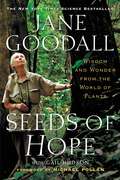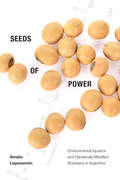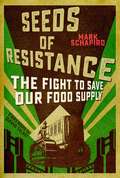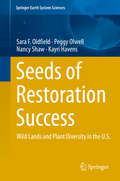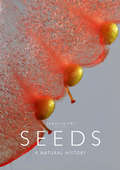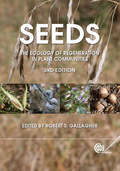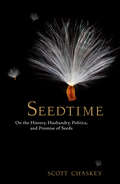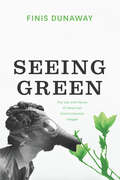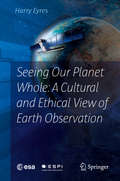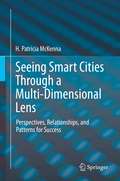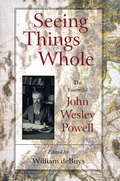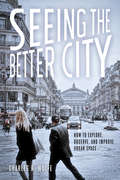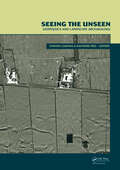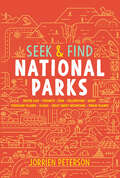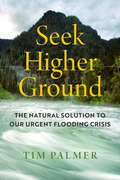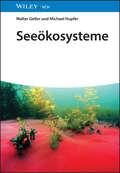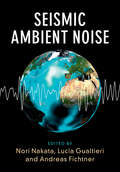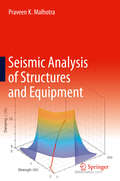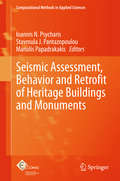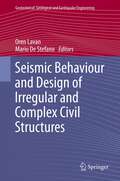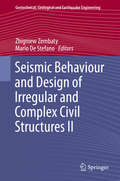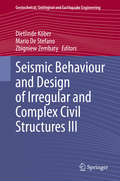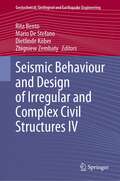- Table View
- List View
Seeds of Hope: Wisdom and Wonder from the World of Plants
by Jane Goodall Michael Pollan Gail HudsonRenowned naturalist and bestselling author Jane Goodall examines the critical role that trees and plants play in our world. In her wise and elegant new book, Jane Goodall blends her experience in nature with her enthusiasm for botany to give readers a deeper understanding of the world around us.Long before her work with chimpanzees, Goodall's passion for the natural world sprouted in the backyard of her childhood home in England, where she climbed her beech tree and made elderberry wine with her grandmother. The garden her family began then, she continues to enjoy today. SEEDS OF HOPE takes us from England to Goodall's home-away-from-home in Africa, deep inside the Gombe forest, where she and the chimpanzees are enchanted by the fig and plum trees they encounter. She introduces us to botanists around the world, as well as places where hope for plants can be found, such as The Millennium Seed Bank, where one billion seeds are preserved. She shows us the secret world of plants with all their mysteries and potential for healing our bodies as well as Planet Earth.Looking at the world as an adventurer, scientist, and devotee of sustainable foods and gardening-and setting forth simple goals we can all take to protect the plants around us-Jane Goodall delivers an enlightening story of the wonders we can find in our own backyards.
Seeds of Power: Environmental Injustice and Genetically Modified Soybeans in Argentina
by Amalia LeguizamónIn 1996 Argentina adopted genetically modified (GM) soybeans as a central part of its national development strategy. Today, Argentina is the third largest global grower and exporter of GM crops. Its soybeans—which have been modified to tolerate being sprayed with herbicides—now cover half of the country's arable land and represent a third of its total exports. While soy has brought about modernization and economic growth, it has also created tremendous social and ecological harm: rural displacement, concentration of landownership, food insecurity, deforestation, violence, and the negative health effects of toxic agrochemical exposure. In Seeds of Power Amalia Leguizamón explores why Argentines largely support GM soy despite the widespread damage it creates. She reveals how agribusiness, the state, and their allies in the media and sciences deploy narratives of economic redistribution, scientific expertise, and national identity as a way to elicit compliance among the country’s most vulnerable rural residents. In this way, Leguizamón demonstrates that GM soy operates as a tool of power to obtain consent, to legitimate injustice, and to quell potential dissent in the face of environmental and social violence.
Seeds of Resistance: The Fight to Save Our Food Supply
by David Talbot Mark SchapiroSun. Soil. Water. Seed. These are the primordial ingredients for the most essential activity of all on earth: growing food. All of these elements are being changed dramatically under the pressures of corporate consolidation of the food chain, which has been accelerating just as climate change is profoundly altering the conditions for growing food. In the midst of this global crisis, the fate of our food has slipped into a handful of the world’s largest companies. Food Chained will bring home what this corporate stranglehold is doing to our daily diet, from the explosion of genetically modified foods to the rapid disappearance of plant varieties to the elimination of independent farmers who have long been the bedrock of our food supply.Food Chained will touch many nerves for readers, including concerns about climate change, chronic drought in essential farm states like California, the persistence of the junk food culture, the proliferation of GMOs, and the alarming domination of the seed market and our very life cycle by global giants like Monsanto.But not all is bleak when it comes to the future of our food supply. Food Chained will also present hopeful stories about farmers, consumer groups, and government agencies around the world that are resisting the tightening corporate squeeze on our food chain.
Seeds of Restoration Success: Wild Lands and Plant Diversity in the U.S. (Springer Earth System Sciences)
by Nancy Shaw Kayri Havens Sara F. Oldfield Peggy OlwellThis book provides a general overview of the natural landscapes and vegetation types of the U.S., the key plant species that help define them, the pressures faced by natural ecosystems and the imperative for conservation and restoration. It addresses the policies that have been introduced to manage healthy ecosystems and the practical progress that is being made in restoration. A particular focus is on the production of diverse native plant materials currently required by the National Seed Strategy. Case studies demonstrate how native plant materials are essential to support the conservation of healthy ecosystems with their biodiversity and functions as well as supporting a productive and sustainable agricultural sector and healthy ecosystems for all. The authors are closely connected with major national and international networks of botanic gardens, ecologists and conservation scientists at Board level and through other professional links. Condensing a wide range of current information into a concise format, this book fills a need by experts and informed amateurs interested in the natural environment, including gardeners, botanic garden and protected area visitors, government agencies, the private sector native seed industry, and NGOs.
Seeds: A Natural History
by Carolyn FryFrom the magnificence of a towering redwood to the simple elegance of a tiny dandelion, seed-bearing plants abound on planet Earth. The sheer diversity of plants thriving today is largely thanks to the evolution of the seed, as this made plants resilient to environmental changes by enabling them to await optimum conditions for growth before springing to life. In a time of declining biodiversity, studying seeds is now helping scientists preserve this plant diversity for future generations. With Seeds, Carolyn Fry offers a celebration of these vital but unassuming packages of life. She begins with a sweeping tour through human history, designed to help us understand why we should appreciate and respect these floral parcels. Wheat, corn, and rice, she reminds us, supply the foundations of meals eaten by people around the world. Countless medicines, oils, clothing materials, and building supplies are available only because of the versatility and variety of seed-bearing plants. Fry then provides a comprehensive history of the evolution of seeds, explaining the myriad ways that they have adapted, survived, and thrived across the globe. Delving deeper into the science of seeds, she reveals the fascinating processes of dormancy, reproduction, germination, and dispersal, and showcases the estimable work conservationists are doing today to gather and bank seeds in order to prevent species from going extinct. Enriched by a stunning array of full-color images, Seeds offers a comprehensive exploration of some of the most enduring and essential players in the natural world.
Seeds: The Ecology of Regeneration in Plant Communities
by Robert S. GallagherThis 3rd edition highlights many advances in the field of seed ecology and its relationship to plant community dynamics over recent years. It features chapters on seed development and morphology, seed chemical ecology, implications of climate change on regeneration, and the functional role of seed banks in agricultural and natural ecosystems.
Seedtime: On the History, Husbandry, Politics and Promise of Seeds
by Scott ChaskeyScott Chaskey—working farmer, poet, and spiritual father of the community farming movement—considers "the web of biodiversity and resilience at the heart of our cultural inheritance" by masterfully weaving history, politics, botany, literature, mythology, and memoir into a beautiful and instructive book.It's hard to think of a subject more fundamental to the sustenance of the human race than seeds. Having coevolved with the Earth's plants, insects, and animals, seeds are entwined with the core myths of ancient cultures and the development of human consciousness. Their story remains vitally important today, as the corporations that manufacture GMOs threaten our food security and the future of seed-cultivated agriculture.The stakes, for those concerned with preserving biodiversity and ecological integrity, are high. Balancing a wide view of politics and history, Chaskey alights from life on the farm he has cultivated for 25 years to conjure Gregor Mendel's breeding experiments that yielded our modern understanding of genetics; he also introduces us to several "bioneers," such as the geobotanist Nikolay Vavilov and agriculturalist Cary Fowler, who are preserving global biodiversity through seeds. Integrating scholarship with accessible storytelling, Seedtime is a celebration as well as a call to action urging us to renew our role as citizens of nature, in ecologist Aldo Leopold's phrase, not as conquerors of it.
Seeing Green: The Use and Abuse of American Environmental Images
by Finis DunawayAmerican environmentalism is defined by its icons: the "Crying Indian,” who shed a tear in response to litter and pollution; the cooling towers of Three Mile Island, site of a notorious nuclear accident; the sorrowful spectacle of oil-soaked wildlife following the ExxonValdez spill; and, more recently, Al Gore delivering his global warming slide show in An Inconvenient Truth. These images, and others like them, have helped make environmental consciousness central to American public culture. Yet most historical accounts ignore the crucial role images have played in the making of popular environmentalism, let alone the ways that they have obscured other environmental truths. Finis Dunaway closes that gap with Seeing Green. Considering a wide array of images--including pictures in popular magazines, television news, advertisements, cartoons, films, and political posters--he shows how popular environmentalism has been entwined with mass media spectacles of crisis. Beginning with radioactive fallout and pesticides during the 1960s and ending with global warming today, he focuses on key moments in which media images provoked environmental anxiety but also prescribed limited forms of action. Moreover, he shows how the media have blamed individual consumers for environmental degradation and thus deflected attention from corporate and government responsibility. Ultimately, Dunaway argues, iconic images have impeded efforts to realize--or even imagine--sustainable visions of the future. Generously illustrated, this innovative book will appeal to anyone interested in the history of environmentalism or in the power of the media to shape our politics and public life.
Seeing Our Planet Whole: A Cultural and Ethical View of Earth Observation
by Harry EyresThis book shows how our new-found ability to observe the Earth from "the necessary distance" has wide and profound cultural and ethical implications. First of all, it is the outcome of speculations and investigations of human beings in relation to their home planet carried out over millennia. In particular, it reveals a split between the ancient idea of the Earth as nurturing mother and the more recent conception of the Earth as a neutral resource able to be infinitely exploited by humankind. The 1968 Earthrise photograph, showing the beauty and fragility of the Earth, helped spark a worldwide environmental movement; now the comprehensive coverage of global change provided by satellites has the potential to convince us beyond reasonable doubt of the huge alterations being wrought upon the Earth and its climate system as a result of human actions, and of the need to act more responsibly.
Seeing Smart Cities Through a Multi-Dimensional Lens: Perspectives, Relationships, and Patterns for Success
by H. Patricia McKennaThis book provides an interdisciplinary lens for exploring, assessing, and coming to new understandings of smart cities and regions, focusing on the six dimensions of sensing, awareness, learning, openness, innovation, and disruption. Using a hybrid case study and correlational approach, people from diverse sectors in a variety of small to medium to large-sized cities in multiple countries (e.g., Canada, United States, Ireland, Greece, Israel, etc.) provide experience-based perspectives on smart cities together with assessments for elements pertaining to each of the six dimensions.The analysis of findings in this work surfaces a rich and interwoven tapestry of patterns from the qualitative data highlighting for example, the importance of emotion/affect, privacy, trust, and data visualizations in influencing and informing the directions of smart cities and regions going forward. Correlational analysis of quantitative data reveals the presence and strength of emerging relationships among elements assessed, shedding light on factors that may serve as starting points for understanding what is contributing to potentials for improving success in smart cities and regions.
Seeing Things Whole: The Essential John Wesley Powell (Pioneers of Conservation)
by John Wesley Powell William DebuysJohn Wesley Powell was an American original. He was the last of the nation's great continental explorers and the first of a new breed of public servant: part scientist, part social reformer, part institution builder. His work and life reveal an enduringly valuable way of thinking about land, water, and society as parts of an interconnected whole; he was America's first great bioregional thinker.Seeing Things Whole presents John Wesley Powell in the full diversity of his achievements and interests, bringing together in a single volume writings ranging from his gripping account of exploring the Colorado River through the Grand Canyon to his views on the evolution of civilization, along with the seminal writings in which he sets forth his ideas on western settlement and the allocation and management of western resources.The centerpiece of Seeing Things Whole is a series of selections from the famous 1878 Report on the Lands of the Arid Region and related magazine articles in which Powell further develops the themes of the report. John Wesley Powell's bioregional vision remains a model for governance that many westerners see as a viable solution to the resource management conflicts that continue to plague the region.Throughout the collection, award-winning writer and historian William deBuys brilliantly sets the historical context for Powell's work. Section introductions and extensive descriptive notes take the reader through the evolution of John Wesley Powell's interests and ideas from his critique of Social Darwinism and landmark categorization of Indian languages to the climactic yet ultimately futile battles he fought to win adoption of his land-use proposals.Seeing Things Whole presents the essence of the extraordinary legacy that John Wesley Powell has left to the American people, and to people everywhere who strive to reconcile the demands of society with the imperatives of the land.
Seeing the Better City: How to Explore, Observe, and Improve Urban Space
by Charles R. WolfeIn order to understand and improve cities today, personal observation remains as important as ever. While big data, digital mapping, and simulated cityscapes are valuable tools for understanding urban space, using them without on-the-ground, human impressions risks creating places that do not reflect authentic local context. Seeing the Better City brings our attention back to the real world right in front of us, focusing it once more on the sights, sounds, and experiences of place in order to craft policies, plans, and regulations to shape better urban environments.Through clear prose and vibrant photographs, Charles Wolfe shows those who experience cities how they might catalog the influences of urban form, neighborhood dynamics, public transportation, and myriad other basic city elements that impact their daily lives. He then shares insights into how they can use those observations to contribute to better planning and design decisions. Wolfe calls this the "urban diary” approach, and highlights how the perspective of the observer is key to understanding the dynamics of urban space. He concludes by offering contemporary examples and guidance on how to use carefully recorded and organized observations as a tool to create change in urban planning conversations and practice.From city-dwellers to elected officials involved in local planning and design issues, this book is an invaluable tool for constructive, creative discourse about improving urban space.
Seeing the Unseen. Geophysics and Landscape Archaeology
by Salvatore Piro Stefano CampanaSEEING THE UNSEEN. GEOPHYSICS AND LANDSCAPE ARCHAEOLOGY is a collection of papers presented at the advanced XV International Summer School in ArchaeologyGeophysics for Landscape Archaeology (Grosseto, Italy, 10-18 July 2006). Bringing together the experience of some of the worlds greatest experts in the field of archaeological prospection, the
Seek & Find National Parks: Crater Lake, Yosemite, Zion, Yellowstone, Banff, Thousand Islands, Acadia, Great Smoky Mountains, Virgin Islands (Seek & Find)
by Jorrien PetersonLearn about the plants and animals in nine national parks with fun facts, engaging questions, and intricate illustrations.Explore your world top to bottom with Seek & Find National Parks to learn what makes each park totally unique. See if you can spot the recurring shapes hidden throughout the illustrations, such as bighorn sheep, American black bears, and giant sequoias. Seek and find these animals and plants, and many more in their national park homes. A helpful glossary provides details for further discovery. National parks featured include: Acadia (Maine), Banff (Alberta), Crater Lake (Oregon), the Great Smoky Mountains (Tennessee/North Carolina), Thousand Islands (Ontario), US Virgin Islands, Yellowstone (Wyoming/Montana/Idaho), Yosemite (California), and Zion (Utah).
Seek Higher Ground: The Natural Solution to Our Urgent Flooding Crisis
by Tim PalmerPairing in-depth journalism with historical perspectives, this book makes a compelling case for a natural solution to the growing problem of flooding. With Seek Higher Ground, environmental writer and former land-use planner Tim Palmer explores the legacy of flooding in America, taking a fresh look at the emerging climatic, economic, and ecological realities of our rivers and communities. Global warming is forecast to sharply intensify flooding, and this book urges that we reduce future damage in the most effective, efficient, and equitable ways possible. Through historical narrative, rigorous reporting, and decades of vivid personal experience, Palmer details how our society’s approach to flood control has been infamously inadequate and chronically counterproductive. He builds a powerful argument for both the protection of floodplain open space and for programs that help people voluntarily relocate their homes away from high-water hazards. Only by recognizing the indomitable forces of nature—and adapting to them—can we thrive in the challenging climate to come.
Seeökosysteme
by Walter Geller Michael HupferSeen sind ein zentraler Bestandteil der mitteleuropäischen Landschaften mit einem hohen Nutzwert für Wasserversorgung, Binnenfischerei, Freizeit und Artenschutz. Sie besitzen ein komplexes Ökosystem, das von vielen unterschiedlichen Faktoren wie Temperatur, Nährstoffeintrag sowie der Art und Anzahl der im See lebenden Mikroorganismen, Pflanzen und Tiere abhängt. Die Kenntnis aller dieser Faktoren und ihres Zusammenspiels ist die entscheidende Voraussetzung, um das Ökosystem See zu verstehen, zu überwachen und ggf. schützend einzugreifen, wenn dieses aus der Balance gerät. Diese umfassende Übersicht zur Ökologie von Seen basiert auf neuesten Erkenntnissen und zahlreichen wissenschaftlichen Studien aus den vergangenen zwei Jahrzehnten. Zunächst werden die abiotischen Faktoren wie Temperatur, Licht und Sauerstoffverhältnisse und deren Einfluss auf die Gliederung von Seen in unterschiedliche Habitate und ökologische Nischen beschrieben. Weitere Kapitel befassen sich mit den Organismen im See, vom Phytoplankton und Zooplankton bis hin zu höheren Pflanzen und Tieren, deren Populationsbiologie, sowie den daraus entstehenden ökologischen Netzen. Der Einfluss invasiver Arten wird anhand von mehreren Beispielen dokumentiert. Dieses Standardwerk zur Ökologie von Seen erklärt und dokumentiert anhand von umfangreichem Datenmaterial den Stand des Wissens und ist ein zuverlässiger Begleiter für Ausbildung und Beruf.
Seismic Ambient Noise
by Andreas Fichtner Nori Nakata Lucia GualtieriThe seismic ambient field allows us to study interactions between the atmosphere, the oceans and the solid Earth. The theoretical understanding of seismic ambient noise has improved substantially in the last decades, and the number of its applications has increased dramatically. With chapters written by eminent scientists from the field, this book covers a range of topics including ambient noise observations, generation models of their physical origins, numerical modelling and processing methods. The later chapters focus on applications in imaging and monitoring the internal structure of the Earth, including interferometry for time-dependant imaging and tomography. This volume thus provides a comprehensive overview of this cutting-edge discipline for graduate students studying geophysics and for scientists working in seismology and other imaging sciences.
Seismic Amplitude: An Interpreter's Handbook
by Rob Simm Mike BaconSeismic amplitudes yield key information on lithology and fluid fill, enabling interpretation of reservoir quality and likelihood of hydrocarbon presence. The modern seismic interpreter must be able to deploy a range of sophisticated geophysical techniques, such as seismic inversion, AVO (amplitude variation with offset), and rock physics modelling, as well as integrating information from other geophysical techniques and well data. This accessible, authoritative book provides a complete framework for seismic amplitude interpretation and analysis in a practical manner that allows easy application - independent of any commercial software products. Deriving from the authors' extensive industry expertise and experience of delivering practical courses on the subject, it guides the interpreter through each step, introducing techniques with practical observations and helping to evaluate interpretation confidence. Seismic Amplitude is an invaluable day-to-day tool for graduate students and industry professionals in geology, geophysics, petrophysics, reservoir engineering, and all subsurface disciplines making regular use of seismic data.
Seismic Analysis of Structures and Equipment
by Praveen K. MalhotraThis book describes methods used to estimate forces and deformations in structures during future earthquakes. It synthesizes the topics related to ground motions with those related to structural response and, therefore, closes the gap between geosciences and engineering. Requiring no prior knowledge, the book elucidates confusing concepts related to ground motions and structural response and enables the reader to select a suitable analysis method and implement a cost‐effective seismic design.Presents lucid, accessible descriptions of key concepts in ground motions and structural response and easy to follow descriptions of methods used in seismic analysis;Explains the roles of strength, deformability, and damping in seismic design;Reinforces concepts with real‐world examples;Stands as a ready reference for performance‐based/risk-based seismic design, providing guidance for achieving a cost-effective seismic design.
Seismic Assessment, Behavior and Retrofit of Heritage Buildings and Monuments
by Manolis Papadrakakis Ioannis N. Psycharis Stavroula J. PantazopoulouThis book assembles, identifies and highlights the most recent developments in Rehabilitation and retrofitting of historical and heritage structures. This is an issue of paramount importance in countries with great built cultural heritage that also suffer from high seismicity, such as the countries of the eastern Mediterranean basin. Heritage structures range from traditional residential constructions to monumental structures, ancient temples, towers, castles, etc. It is generally recognized that these structures present particular difficulties in seismic response calculation through computer simulation due to the complexity of the structural system which is, generally, inhomogeneous, with several contact problems, gaps/joints, nonlinearities and brittleness in material constituents. This book contains selected papers from the ECCOMAS Thematic Conferences on Computational Methods in Structural Dynamics & Earthquake Engineering (COMPDYN) that were held in Corfu, Greece in 2011 and Kos, Greece in 2013. The Conferences brought together the scientific communities of Computational Mechanics, Structural Dynamics and Earthquake Engineering in an effort to facilitate the exchange of ideas in topics of mutual interest and to serve as a platform for establishing links between research groups with complementary activities.
Seismic Behaviour and Design of Irregular and Complex Civil Structures
by Mario De Stefano Oren LavanStructural irregularities are one of the most frequent causes of severe damages in buildings, as evidenced by the numerous earthquakes in recent years. This issue is of particular importance, since real structures are almost all irregular. Furthermore, structural irregularities depend on several factors often very difficult to predict. This book is an essential tool for understanding the problem of structural irregularities and provides the most up-to-date review on this topic, covering the aspects of ground rotations, analysis, design, control and monitoring of irregular structures. It includes 24 contributions from authors of 13 countries, giving a complete and international view of the problem.
Seismic Behaviour and Design of Irregular and Complex Civil Structures II
by Mario De Stefano Zbigniew ZembatyIrregular engineering structures are subjected to complicated additional loads which are often beyond conventional design models developed for traditional, simplified plane models. This book covers detailed research and recent progress in seismic engineering dealing with seismic behaviour of irregular and set-back engineering structures. Experimental results as well as special topics of modern design are discussed in detail. In addition, recent progress in seismology, wave propagation and seismic engineering, which provides novel, modern modelling of complex seismic loads, is reported. Particular emphasis is placed on the newly developed rotational, seismic ground-motion effects. This book is a continuation of an earlier monograph which appeared in the same Springer series in 2013 (http://www. springer. com/gp/book/9789400753761).
Seismic Behaviour and Design of Irregular and Complex Civil Structures III (Geotechnical, Geological and Earthquake Engineering #48)
by Mario De Stefano Zbigniew Zembaty Dietlinde KöberThis book presents state-of-the-art knowledge on problems of the effects of structural irregularities on their seismic response. It also covers specific spatial and rotational seismic loads on these structures. Rapid progress in respective research on irregular structures and unconventional seismic loads requires prompt updates of the state of the art in this area. These problems are of particular interest to both researchers and practitioners because these are non-conservative effects compared with the approach of the traditional seismic design (e.g. Eurocode 8, Uniform Building Code etc.). This book will be of particular interest to researchers, PhD students and engineers dealing with design of structures under seismic excitations.
Seismic Behaviour and Design of Irregular and Complex Civil Structures IV (Geotechnical, Geological and Earthquake Engineering #50)
by Mario De Stefano Zbigniew Zembaty Dietlinde Köber Rita BentoThis volume contains papers of the 9th European Workshop on the Seismic Behaviour of Irregular and Complex Structures (9EWICS) held in Lisbon, Portugal, in 2020. This workshop, organized at Instituto Superior Técnico, University of Lisbon, continued the successful three-annual series of workshops started back in 1996. Its organization had the sponsorship of Working Group 8 (Seismic Behaviour of Irregular and Complex Structures) of the European Association of Earthquake Engineering.This international event provided a platform for discussion and exchange of ideas and unveiled new insights on the possibilities and challenges of irregular and complex structures under seismic actions. The topics addressed include criteria for regularity, seismic design of irregular structures, seismic assessment of irregular and complex structures, retrofit of irregular and complex structures, and soil-structure interaction for irregular and complex structures. Beyond an excellent number of interesting papers on these topics, this volume includes the papers of the two invited lectures – one devoted to irregularities in RC buildings, including perspectives in current seismic design codes, difficulties in their application and further research needs, and another one dedicated to the challenging and very up to date topic in the area of seismic response of masonry building aggregates in historical centers. This volume includes 26 contributions from authors of 11 countries, giving a complete and international view of the problem.The holds particular interest for all the community involved in the challenging task of seismic design, assessment and/or retrofit of irregular and complex structures.
